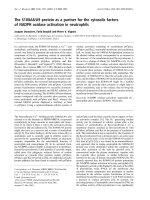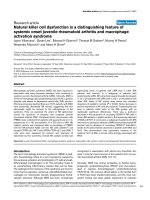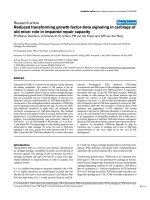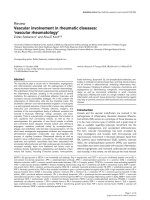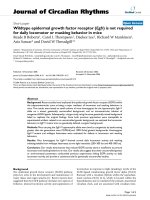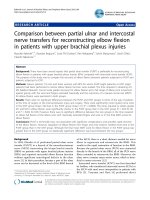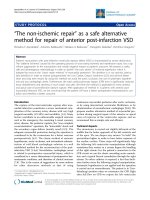Báo cáo y học: " Vascular endothelial growth factor as a non-invasive marker of pulmonary vascular remodeling in patients with bronchitis-type of COPD" pot
Bạn đang xem bản rút gọn của tài liệu. Xem và tải ngay bản đầy đủ của tài liệu tại đây (262.59 KB, 7 trang )
BioMed Central
Page 1 of 7
(page number not for citation purposes)
Respiratory Research
Open Access
Research
Vascular endothelial growth factor as a non-invasive marker of
pulmonary vascular remodeling in patients with bronchitis-type of
COPD
Hiroshi Kanazawa*, Kazuhisa Asai and Saeko Nomura
Address: Department of Respiratory Medicine, Graduate School of Medicine, Osaka City University, 1-4-3, Asahi-machi, Abenoku, Osaka, 545-
8585, Japan
Email: Hiroshi Kanazawa* - ; Kazuhisa Asai - ; Saeko Nomura -
* Corresponding author
Abstract
Background: Several studies have indicated that one of the most potent mediators involved in
pulmonary vascular remodeling is vascular endothelial growth factor (VEGF). This study was
designed to determine whether airway VEGF level reflects pulmonary vascular remodeling in
patients with bronchitis-type of COPD.
Methods: VEGF levels in induced sputum were examined in 23 control subjects (12 non-smokers
and 11 ex-smokers) and 29 patients with bronchitis-type of COPD. All bronchitis-type patients
performed exercise testing with right heart catheterization.
Results: The mean pulmonary arterial pressure (mPAP) and pulmonary vascular resistance (PVR)
after exercise were markedly increased in all bronchitis-type patients. However, both parameters
after exercise with breathing of oxygen was significantly lower than in those with breathing of room
air. To attenuate the effect of hypoxia-induced pulmonary vasoconstriction during exercise, we
used the change in mPAP or PVR during exercise with breathing of oxygen as a parameter of
pulmonary vascular remodeling. Change in mPAP was significantly correlated with VEGF level in
induced sputum from patients with chronic bronchitis (r = 0.73, p = 0.0001). Moreover, change in
PVR was also correlated with VEGF level in those patients (r = 0.57, p = 0.003).
Conclusion: A close correlation between magnitude of pulmonary hypertension with exercise
and VEGF level in bronchitis-type patients could be observed. Therefore, these findings suggest the
possibility that VEGF level in induced sputum is a non-invasive marker of pulmonary vascular
remodeling in patients with bronchitis-type of COPD.
Background
Pulmonary vascular remodeling leading to pulmonary
hypertension is a characteristic feature of chronic obstruc-
tive pulmonary disease (COPD), and has been associated
with the development of COPD [1]. In agreement with
this notion, previous studies have suggested that the nat-
ural history of pulmonary hypertension in COPD might
commence at moderate degrees of disease severity [2]. In
fact, hypoxia has been classically considered the major
pathogenic mechanism of pulmonary vascular remode-
ling in COPD. However, structural abnormalities of pul-
monary arteries are not exclusive of advanced COPD,
Published: 8 March 2007
Respiratory Research 2007, 8:22 doi:10.1186/1465-9921-8-22
Received: 14 September 2006
Accepted: 8 March 2007
This article is available from: />© 2007 Kanazawa et al; licensee BioMed Central Ltd.
This is an Open Access article distributed under the terms of the Creative Commons Attribution License ( />),
which permits unrestricted use, distribution, and reproduction in any medium, provided the original work is properly cited.
Respiratory Research 2007, 8:22 />Page 2 of 7
(page number not for citation purposes)
since they have been shown also in patients with mild
COPD without arterial hypoxemia and even in smokers
with normal lung function [3]. Wright et al. also found an
increase in wall area of small pulmonary vessels by inti-
mal thickening in patients with mild to moderate COPD
and medial thickening in severe cases [4]. Thus, since
patients with mild COPD are not usually hypoxemic, the
etiology of pulmonary vascular remodeling remains
uncertain.
One important pathological feature of COPD is chronic
inflammation characterized by an influx of inflammatory
cells, predominantly neutrophils, macrophages, and
CD8+ T lymphocytes, into the airway walls and paren-
chyma [5]. COPD, a syndrome of variable phenotype, is
mostly caused by inhaled cigarette smoke. Over time,
alveolar destruction results in emphysema, and chronic
airway inflammation leads to chronic bronchitis. Chronic
bronchitis is a clinical syndrome defined by chronic
cough and sputum production. In chronic bronchitis, air-
way inflammation is associated with structural alterations
including an increase in the amount of smooth muscle
and connective tissue in the airway wall [6]. Moreover,
previous observations have indicated that pulmonary
arteries in patients with chronic bronchitis have increased
adventitial infiltration of activated T lymphocytes [7,8].
Therefore, active airway inflammation might affect pul-
monary vascular remodeling in chronic bronchitis. In
contrast, it has been supposed that emphysema may lead
to loss of the pulmonary vascular bed [9]. The Global Ini-
tiative for Obstructive Lung Disease (GOLD) Workshop
Report defines COPD as a disease state characteristics by
airflow limitation that is not fully reversible [10]. This
chronic airflow limitation characteristic of COPD is attrib-
uted to a mixture of two manifestations involved in
COPD: parenchymal destruction (emphysema) and small
airway disease (obstructive bronchiolitis). The GOLD def-
inition differs from many previous definitions of COPD,
which emphasized the terms of emphysema and chronic
bronchitis. According to GOLD, the relative contribution
of parenchymal destruction and small airway disease
toward airflow limitation varies in individuals.
A previous study revealed endothelial dysfunction in pul-
monary arteries of patients with mild COPD [11]. Sub-
jects with greater impairment of endothelial function had
more pronounced pulmonary vascular remodeling, such
as intimal thickening. Because the endothelium plays a
central role in regulating vascular tone and controlling cell
growth, the impairment of endothelial function might
promote pulmonary vascular remodeling at this early
stage of COPD. To date, it is not known which mediators
are involved in this process. However, several studies have
indicated that one of the most potent mediators involved
in pulmonary vascular remodeling is vascular endothelial
growth factor (VEGF) [12]. VEGF promotes an array of
responses in endothelial cell proliferation and angiogen-
esis with new vessel formation in vivo [13]. These findings
may suggest the potential roles of VEGF in the pathogen-
esis of pulmonary vascular remodeling. Therefore, we
attempted to determine whether airway VEGF level
reflects pulmonary vascular remodeling in patients with
bronchitis-type of COPD.
Methods
Subjects
All COPD patients satisfied the GOLD criteria for the diag-
nosis, and were selected from the respiratory outpatient
clinic of our institution. They have undergone the evalua-
tion for low attenuation area (LAA) on high-resolution
computed tomographic scans (HRCT) of the lungs prior
to the entry of this study. Four slices 1 mm thick were
obtained at three anatomical levels at full inspiration, that
is, near the superior margin of the aortic arch (level of the
upper lung field), at the level of the carina (level of the
middle lung field), and at the level of the orifice of the
inferior pulmonary veins (level of the lower lung field).
LAA were scored visually in each bilateral lung field
according to the method of Goddard et al. [14]. Total
scores were calculated and the severity of emphysema was
graded as follows; score 0, LAA < 5%; score 1, 5% < LAA <
25%; score 2, 25% < LAA < 50%; score 3, 50% < LAA <
75%; score 4, LAA > 75%. Grade 0, total score = 0; grade
1, total score = 1–6, grade 2, total score = 7–12; grade 3,
total score = 13–18; grade 4, total score = 19–24. HRCT
images were analyzed independently by two chest physi-
cians with no knowledge of the clinical information. The
patients were classified according to the visual HRCT find-
ings as follows: absence of emphysema, which showed lit-
tle emphysema and LAA grade < 1, reflecting small airway
disease (bronchitis-type), and presence of emphysema,
which showed apparent emphysema > grade 2, reflecting
parenchymal destruction (emphysema-type). Thus, bron-
chitis-type of COPD was defined as cough and sputum
production occurring on most days of the month for at
least 3 months a year during the 2 years prior to the study
and on the basis of the HRCT findings (HRCT total score
< 6). Finally, 29 patients with bronchitis-type of COPD
(classification of severity in GOLD: 3 mild, 23 moderate,
and 3 severe) and 23 normal control subjects (12 non-
smokers and 11 ex-smokers) were included in the study.
All control subjects were healthy, who had no history of
respiratory disease. Bronchitis-type patients had no exac-
erbation, which were defined as increased dyspnea associ-
ated with a change in the quality and quantity of sputum
that led the subject to seek medical attention, during the
1 month preceding the study. All patients had been free of
acute upper respiratory tract infections and none had
received glucocorticoids or antibiotics within the 1 month
preceding the study, or bronchodilators within the previ-
Respiratory Research 2007, 8:22 />Page 3 of 7
(page number not for citation purposes)
ous 48 hours of exercise testing. Their regular medication
consisted of inhaled short-acting anticholinergic agents
and the beta2-agonist salbutamol on demand.
The subjects were non-atopic (i.e., they had negative skin
tests for common allergen extracts) and had no past his-
tory of asthma or allergic rhinitis. Pulmonary function
tests including the diffusing capacity of the lung for car-
bon monoxide (Dlco) were performed within the 1 week
before this study. Patients with evidence of coronary
artery disease, valvular heart disease, systemic hyperten-
sion, or primary myocardial disease were excluded from
the study. None of the patients had radiological or clinical
evidence of pulmonary congestion or right heart failure.
Concomitant left ventricular dysfunction was excluded in
all patients by echocardiography and determination of
pulmonary wedge pressure (PWP). No subjects in this
study were included as subjects in our previous study. All
patients gave their written informed consent for participa-
tion in this study, which was approved by the Ethics Com-
mittee of Osaka City University, Japan. This investigation
conforms with the principles outlined in the Declaration
of Helsinki.
Exercise test
On the first day of the study, all bronchitis-type patients
underwent a progressive incremental exercise test while
sitting on an ergometer (EM840; Siemens, Germany),
starting at 0 W for 3 minutes and adding 10 W every
minute until the symptom-limited maximum was
reached, as we previously described [15]. The purpose of
the incremental exercise test was to determine the maxi-
mal exercise capacity. On the day following the test, all
patients underwent right heart catheterization. A balloon-
tipped pulmonary arterial catheter was advanced to the
pulmonary artery for measurement of pulmonary arterial
pressure (PAP) and PWP. In addition, a plastic catheter
was placed into the brachial artery to monitor systemic
arterial pressure and to sample systemic arterial blood.
Cardiac output (CO) was determined by the thermodilu-
tion method, using a Fukuda Denshi CO computer. Arte-
rial oxygen tension (PaO2) was measured with a blood
gas analyzer (Model IL 1312; Instrumentation Labora-
tory). Resting hemodynamic and blood gas data were
obtained about 20 minutes after the patient had been
seated comfortably on the ergometer. Each patient then
performed a constant-load exercise test for 5 minutes
while on the ergometer at a workload corresponding to
60% of the previously determined maximal workload.
Hemodynamic and blood gas measurements were made
during the final minute of constant-load exercise. After
exercise with breathing of room air, 100% oxygen was
given to the patient for 60 minutes via nasal cannula at a
rate of 3 L/min. All of the protocols described above were
repeated while the patient breathed oxygen.
Calculations
From parameters directly measured, the following indices
were derived:
Cardiac index (CI) (L/min/m2) = Cardiac output/Body
surface area,
Pulmonary vascular resistance (PVR) (mmHg/L/min/m2)
= (PAP - PWP)/CI
Sputum induction and processing
Sputum induction was performed three days after the
exercise challenge test, as we previously described [16].
The sputum sample diluted with phosphate-buffered
solution containing dithiothreitol (a final concentration
of 1 mM) was then centrifuged at 400 g for 10 minutes.
The supernatant was stored at -70°C for subsequent assay
of VEGF. VEGF concentration was measured with an
enzyme-linked immunosorbent assay kit (R&D system
Inc, Minneapolis, MN, USA). The minimum detectable
level of VEGF in this assay system is 5.0 pg/mL. All sub-
jects produced an adequate specimen of sputum; a sample
was considered adequate if the patient was able to expec-
torate at least 2 mL of sputum.
Statistical analysis
All values are presented as mean (SD). Multiple compari-
sons were performed by one-way analysis of variance
(ANOVA). When ANOVA revealed a significant differ-
ence, the Bonferroni correction was applied. The signifi-
cance of correlation was evaluated by determining
Spearman's rank correlation coefficients. A p value of less
than 0.05 was considered significant.
Results
The clinical characteristics of the 23 control subjects and
29 patients with bronchitis-type of COPD are summa-
rized in Table 1. The three groups were well matched with
respect to age. However, baseline FEV1 and FEV1/forced
vital capacity was significantly lower in bronchitis-type
patients than in control subjects, and Dlco was also
decreased in bronchitis-type patients. In contrast, the
HRCT score was significantly higher in bronchitis-type
patients than in control subjects. VEGF levels in induced
sputum were also significantly higher in patients with
bronchitis-type patients than in control subjects.
Table 2 shows hemodynamic parameters at rest and after
exercise with breathing of room air or oxygen in bronchi-
tis-type patients. Neither heart rate nor mean arterial pres-
sure at rest or after exercise differed significantly between
breathing of room air and breathing of oxygen. We deter-
mined that exercise-induced hypoxemia was attenuated
by breathing of oxygen in all patients (PaO2 after exercise
without oxygen: range 41–60 mmHg; PaO2 after exercise
Respiratory Research 2007, 8:22 />Page 4 of 7
(page number not for citation purposes)
with oxygen: range 79–94 mmHg). Neither mPAP nor
PVR at rest differed significantly between breathing of
room air and breathing of oxygen. The mPAP and PVR
after exercise were markedly increased in all patients.
However, the mPAP and PVR after exercise with breathing
of oxygen was significantly lower than in those with
breathing of room air (mPAP: p = 0.0009, PVR: p = 0.03).
To attenuate the effect of hypoxia-induced pulmonary
vasoconstriction with exercise, we used the change in
mPAP or PVR during exercise with breathing of oxygen as
a parameter of pulmonary vascular remodeling. Change
in mPAP was significantly correlated with VEGF level in
induced sputum from bronchitis-type patients (r = 0.73, p
= 0.0001) (Fig 1). Moreover, change in PVR was also cor-
related with VEGF level in those patients (r = 0.57, p =
0.003) (Fig 2).
Discussion
The novel aspect of this investigation is the finding of a
close correlation between change in magnitude of pulmo-
nary hypertension from pre- to post-exercise and VEGF
level in sputum samples from bronchitis-type patients. All
previous studies investigating pulmonary vascular remod-
eling were based on an invasive pathologic examination
by using the resected lung specimens. Therefore, we
attempted non-invasive analysis of the degree of pulmo-
nary vascular remodeling. However, to the best of our
knowledge, no information is available on potential
parameters of pulmonary vascular remodeling derived
from physiological and biochemical characterization of
human subjects. In this study, pulmonary hypertension
became particularly pronounced in bronchitis-type
patients during exercise, indicating that the increase in
pulmonary blood flow and hypoxemia during exercise
resulted in an exaggerated pulmonary hypertension. For
this reason, it appeared that bronchitis-type patients had
the ability to accommodate to pulmonary blood flow at
rest, but that they had lost the ability to accommodate
increased pulmonary blood flow through vascular remod-
eling and hypoxic pulmonary vasconstriction with exer-
cise [17]. To enable testing with an attenuated degree of
hypoxic pulmonary vasoconstriction during exercise, we
have performed exercise challenge with breathing of oxy-
gen. In fact, we found that mPAP and PVR after exercise
with breathing of oxygen were significantly lower than
those with breathing of room air. Thus, we determined
that exercise challenge testing with breathing of oxygen is
a reliable method for evaluation of degree of pulmonary
vascular remodeling in bronchitis-type patients. Using
both pulmonary hemodynamic study and histologically
morphological analysis, Kubo and their colleagues have
also reported that pulmonary vascular remodeling is
closely related to exercise-induced pulmonary hyperten-
sion [18]. However, our method is also invasive, since all
Table 2: Hemodynamic parameters at rest and after exercise in
patients with bronchitis-type of COPD
Oxygenation (-) Oxygenation (+)
HR
rest 77 (11) 76 (11)
after exercise 116 (17) 114 (14)
MAP (mmHg)
rest 93 (8) 92 (7)
after exercise 140 (13) 135 (11)
PaO2 (mmHg)
rest 76 (5) 111 (6)**
after exercise 50 (6) 85 (4)**
mPAP (mmHg)
rest 22.9 (1.9) 21.9 (2.0)
after exercise 46.0 (6.2) 41.8 (6.4)**
PVR (mmHg/L/min/m2)
rest 5.97 (0.76) 5.91 (0.81)
after exercise 8.28 (1.21) 7.67 (1.27)*
Abbreviations: HR = heart rate; MAP = mean arterial pressure; PaO2
= arterial oxygen tension;
mPAP = mean pulmonary arterial pressure; PVR = pulmonary vascular
resistance.
** p < 0.01, * p < 0.05 compared with Oxygenation (-).
Data are presented as mean (SD).
Table 1: Clinical characteristics of study subjects
Normal controls Chronic bronchitis
non-smoker ex-smoker
Patient number (male/female) 12 (12/0) 11 (11/0) 29 (29/0)
Age (years) 51.5 (4.5) 55.5 (3.5) 62.0 (5.7)
Smoking (pack-years) 0 26.9 (4.3) 30.7 (3.6)
FEV1 (% predicted) 89.5 (5.5) 83.4 (2.9) 63.7 (8.2)*
FEV1/FVC (%) 80.5 (5.4) 78.9 (3.0) 61.4 (4.9)*
DLCO (%) 97.5 (2.5) 90.5 (3.5) 64.0 (8.0)*
HRCT score 0 1.4 (1.1)* 4.2 (1.3)*
VEGF in sputum (pg/mL) 1950 (950) 1760 (920) 3500 (1070)*
Abbreviations: FEV1 = forced expiratory volume in 1 second; FVC = forced vital capacity;
DLCO = diffusing capacity of lung for carbon monoxide; HRCT = high-resolution computed tomographic scans;
VEGF = vascular endothelial growth factor.
* p < 0.01 compared with normal controls. Data are presented as mean (SD).
Respiratory Research 2007, 8:22 />Page 5 of 7
(page number not for citation purposes)
subjects underwent right heart catheterization followed
by an exercise test. Therefore, a non-invasive marker of
pulmonary vascular remodeling will be required to be
widely used in the clinical investigation in this field.
Cigarette smoking causes an inflammatory reaction in the
arteries of patients with chronic bronchitis. Accordingly,
we hypothesized that the vascular remodeling in pulmo-
nary arteries with bronchitis-type of COPD could be
related to an inflammatory process. Indeed, airway
inflammation has been shown to be involved in the
pathogenesis of some forms of pulmonary hypertension
[19]. Several studies performed in lungs of patients with
mild COPD have shown apparent abnormalities in the
structure of the pulmonary arteries, in most cases consist-
ing of the thickening of the intimal layer [20]. Interest-
ingly, the intensity of the intimal thickening has been
shown to correlate with the severity of the inflammatory
infiltrates in small airways, suggesting that an inflamma-
tory process might also account for the vascular remode-
ling of pulmonary arteries [21,22]. A potential
mechanism for the increased number of inflammatory
cells in pulmonary arteries of patients with bronchitis-
type of COPD could be their migration from adjacent
bronchioles. However, the precise mechanism by which
inflammatory cells may induce pulmonary vascular
remodeling remains unknown. One possibility is that
inflammatory cells constitute a source of cytokines and
growth factors such as VEGF, that may target the endothe-
lial cells and contribute to the development of structural
and functional abnormalities of the vessel walls [23]. In
the present study we found that airway VEGF might influ-
ence pulmonary vascular remodeling. These findings sug-
gest that increased VEGF level contributes to increased
and abnormal proliferation of endothelial and vascular
smooth muscle cells in pulmonary vessels, leading to vas-
cular remodeling. Indeed, VEGF has been found to be
involved in vascular remodeling in primary pulmonary
hypertension, which is characterized by endothelial and
smooth muscle proliferation [24]. Cigarette smoking may
up-regulate the expression of VEGF, as suggested by acute
increase in VEGF levels during smoking [25]. Accordingly,
it has been supposed that VEGF could play a role in the
pathogenesis of the endothelial cell proliferation shown
in pulmonary arteries of smokers. Interestingly, it has
been suggested that decrease in VEGF might be involved
in the pathogenesis of emphysema through apoptotic
mechanisms of pulmonary endothelial cells [26]. In con-
trast, high levels of VEGF induced airway remodeling in
bronchitis-type of COPD [27]. These previous findings
have promoted a growing interest in clarifying that VEGF
may affect pulmonary vascular remodeling of these com-
mon types of COPD. With this background in mind, our
findings indicate the potential role of VEGF in the patho-
genesis of the vascular changes that take place in bronchi-
tis-type of COPD.
We suggested the significant association between airway
VEGF level and degree of pulmonary vascular remodeling.
The high levels of VEGF receptors expression in the pul-
monary vessels were observed in the vascular smooth
muscle cells and endothelial cells of arteries with a diam-
eter of approximately 200
µ
m, which are known to play
an important role in pulmonary blood pressure regula-
tion and vascular resistance. Thus, increased VEGF expres-
sion in the airway of bronchitis-type patients may lead to
increased or even abnormal proliferation of endothelial
and vascular smooth muscle cells in pulmonary vessels.
Correlation between VEGF level in induced sputum and change in PVR during exercise with breathing of oxygen in patients with bronchitis-type of COPDFigure 2
Correlation between VEGF level in induced sputum and
change in PVR during exercise with breathing of oxygen in
patients with bronchitis-type of COPD.
0
1
2
3
4
5
1000 2000 3000 4000 5000 6000
VEGF levels (pg/mL)
Change in PVR
(mmHg/L/min/m2)
r = 0.57
p = 0.003
Correlation between VEGF level in induced sputum and change in mPAP during exercise with breathing of oxygen in patients with bronchitis-type of COPDFigure 1
Correlation between VEGF level in induced sputum and
change in mPAP during exercise with breathing of oxygen in
patients with bronchitis-type of COPD.
10
15
20
25
30
35
1000 2000 3000 4000 5000 6000
Change in mPAP
ᄼᄼᄼᄼ
ᄼᄼᄼᄼᄼᄼᄼᄼ
ᄼᄼᄼᄼ (mmHg)
VEGF levels (pg/mL)
r = 0.73
p = 0.0001
Respiratory Research 2007, 8:22 />Page 6 of 7
(page number not for citation purposes)
Therefore, increased airway VEGF level might closely
reflect the magnitude of pulmonary hypertension with
exercise in bronchitis-type patients. However, further
investigations will be required to confirm our conclusion.
This study has some methodological limitations. First, we
had defined the emphysema-type of COPD as apparent
LAA by HRCT and the bronchitis-type as little evidence of
LAA. However, the HRCT score was significantly higher in
bronchitis-type patients than in normal ex-smokers. In
this study, bronchitis-type patients had very high cigarette
consumption, the reduction in Dlco, and the desaturation
after oxygen even breathing supplemental oxygen. A pre-
vious study also reported that many patients with bron-
chitis-type as well as with emphysema-type had very high
cigarette consumption [28]. This finding suggests that the
sensitivity to smoking in bronchitis-type patients differs
from that in emphysema-type patients, in some way. In
this regard, hereditary predisposition for dominance of
airway disease, but not emphysema, could be an explana-
tion. Moreover, in bronchitis-type patients, obstructive
bronchiolitis reduces airflow leading to impairment of gas
exchange [29]. In the present study, Dlco was found to
decrease in bronchitis-type patients, suggesting that
impairment of gas exchange does not occur solely in
emphysema-type patients. Moreover, it is plausible to
consider bronchitis-type patients as having a mild-degree
of emphysematous lesion that might be undetectable as
LAA on HRCT scanning. In addition, the relative contribu-
tion of parenchymal destruction and small airway disease
toward impairment of gas exchange may vary in individu-
als of bronchitis-type of COPD. Thus, our observation was
consistent with those of Gelb et al. who reported 10 cases
where pseudophysiological emphysema was caused by
severe small airway disease [30]. Therefore, exercise-
induced desaturation can occur in patients with bronchi-
tis-type of COPD. Second, our study subjects include
moderate to severe COPD patients. Our previous study
revealed that VEGF levels in induced sputum were
decreased with severity of COPD [31]. In that study,
almost study subjects consisted of emphysema-type of
COPD, which is a main type of Japanese COPD patients.
In the present study, VEGF levels were higher in bronchi-
tis-type patients compared with control subjects. We also
found that VEGF level in induced sputum was inversely
correlated with FEV1 in bronchitis-type patients, but that
its level was not correlated with Dlco and the fall in PaO2
after exercise. Moreover, the significant correlation
between the change in mPAP and in PVR during exercise
and Dlco could not be observed. These findings suggest
that our results are not affected by pathological features of
emphysema. Moreover, we could observe the significant
correlation between the change in mPAP and in PVR dur-
ing exercise on room air and the VEGF level. However,
exercise challenge on room air may induce hypoxic pul-
monary vasoconstriction. Therefore, it is important to per-
form exercise challenge on oxygen to evaluate the effect of
pulmonary vascular remodeling only. In the present
study, we attempted to examine the roles of high levels of
VEGF in pulmonary vascular remodeling. Therefore, we
included patients with bronchitis-type of COPD only.
However, to better define the relationship between airway
VEGF and pulmonary vascular remodeling, we should
also evaluate bronchitis-type patients not developing
exercise-induced pulmonary hypertension. Moreover,
future studies will be required to determine the direct rela-
tionship between morphological analysis of pulmonary
vascular remodeling and VEGF level in induced sputum in
patients with bronchitis-type of COPD.
Conclusion
These findings suggest the possibility that VEGF level in
induced sputum is a non-invasive marker of pulmonary
vascular remodeling in patients with bronchitis-type of
COPD. Moreover, our results in the present study may
lead to explore mechanisms and treatment of pulmonary
vascular remodeling in these patients.
List of abbreviations used
• ANOVA : one-way analysis of variance
• CI : Cardiac index
• CO : Cardiac output
• COPD : chronic obstructive pulmonary disease
• DLCO : diffusing capacity of the lung for carbon mon-
oxide
• HRCT : high-resolution computed tomographic scans
• LAA : low attenuation area
• PaO2 : arterial oxygen tension
• PAP : pulmonary arterial pressure
• PVR : pulmonary vascular resistance
• PWP : pulmonary wedge pressure
• VEGF : vascular endothelial growth factor
Competing interests
The author(s) declare that they have no competing inter-
ests.
Respiratory Research 2007, 8:22 />Page 7 of 7
(page number not for citation purposes)
Authors' contributions
HK participated in the conception and design, acquisition
of data, analysis and interpretation of data, and drafting of
the manuscript. KA participated in the analysis and inter-
pretation of data, technical support, and critical revision
of the manuscript. SN participated in the analysis and
interpretation of data, technical support, and critical revi-
sion of the manuscript. The article has not been submitted
elsewhere and all co-authors have read and approved the
final manuscript with its conclusions.
Acknowledgements
This work was supported by a Grant-in-Aid for Scientific Research (No.
17590800) from the Japan Society for the Promotion of Science. The
authors thank Miss Yukari Matsuyama for her help in the preparation and
editing of the article.
References
1. Jeffery PK: Remodeling in asthma and chronic obstructive
lung disease. Am J Respir Crit Care Med 2001, 164:S28-38.
2. Kessler R, Faller M, Weitzenblum E, Chaouat A, Aykut A, Ducolone
A, Ehrhart M, Oswald-Mammosser M: Natural history of pulmo-
nary hypertension in a series of 131 patients with chronic
obstructive lung disease. Am J Respir Crit Care Med 2001,
164:219-24.
3. Barbera JA, Riverola A, Roca J, Ramirez J, Wagner PD, Ros D, Wiggs
BR, Rodriguez-Roisin R: Pulmonary vascular abnormalities and
ventilation-perfusion relationships in mild chronic obstruc-
tive pulmonary disease. Am J Respir Crit Care Med 1994,
149:423-9.
4. Wright JL, Petty T, Thurlbeck WM: Analysis of the structure of
the muscular pulmonary arteries in patients with pulmonary
hypertension and COPD: National Institutes of Health noc-
turnal oxygen therapy trial. Lung 1992, 170:109-24.
5. Saetta M, Turato G, Maestrelli P, Mapp CE, Fabbri LM: Cellular and
structural bases of chronic obstructive pulmonary disease.
Am J Respir Crit Care Med 2001, 163:1304-9.
6. Rennard I: Inflammation and repair processes in chronic
obstructive lung disease. Am J Respir Crit Care Med 1999,
160:S12-6.
7. Hale KA, Ewing SL, Gosnell BA, Niewoehner DE: Lung disease in
long-term cigarettes smokers with and without chronic air-
flow obstruction. Am Rev Respir Dis 1984, 130:716-21.
8. Santos S, Peinado VI, Ramirez J, Melgosa T, Roca J, Rodriguez-Roisin
R, Barbera JA: Characterization of pulmonary vascular remod-
eling in smokers and patients with mild COPD. Eur Respir J
2002, 19:632-8.
9. Kanazawa H, Hirata k, Yoshikawa J: Imbalance between vascular
endothelial growth factor and endostatin in emphysema. Eur
Respir J 2003, 22:609-12.
10. Global Initiative for Chronic Obstructive Lung Disease: Global
strategy for the diagnosis, management and prevention of
chronic obstructive pulmonary disease. NHLBI/WHO
Workshop Report. Bethesda, MD: National Heart, Lung, and
Blood Institute; 2001. Update of the management sections 2003.
11. Peinado VI, Barbera JA, Ramirez J, Gomez FP, Roca J, Jover L, Gimfer-
rer JM, Rodriguez-Rosin R: Endothelial dysfunction in pulmo-
nary arteries of patients with COPD. Am J Physiol 1998,
274:L908-13.
12. Greenway S, van Suylen RJ, Sarvaas GDM, Kwan E, Ambartsumian N,
Lukanidin E, Ravinovitch M: S100A4/Mts1 produces murine pul-
monary artery changes resembling plexogenic arteriopathy
and is increased in human plexogenic arteriopathy. Am J
Pathol 2004, 164:253-62.
13. Ferrara N, Davis-Smyth T: The biology of vascular endothelial
growth factor. Endocr Rev 1997, 18:4-25.
14. Goddard PR, Nicholson EM, Laszlo G, Watt I: Computed tomog-
raphy in pulmonary emphysema. Clin Radiol 1982, 33:379-87.
15. Kanazawa H, Okamoto T, Hirata K, Yoshikawa J: Deletion poly-
morphisms in the angiotensin converting enzyme gene are
associated with pulmonary hypertension evoked by exercise
challenge in patients with chronic obstructive pulmonary
disease. Am J Respir Crit Care Med 2000, 162:1235-8.
16. Kanazawa H, Nomura S, Yoshikawa J: Role of microvascular per-
meability on physiologic differences in asthma and eosi-
nophilic bronchitis. Am J Respir Crit Care Med 2004, 169:1125-30.
17. Voelker NF, Cool CD: Pulmonary vascular involvement in
chronic obstructive pulmonary disease. Eur Respir J 2003,
22:S28-32.
18. Kubo K, Ge Re-Li, Koizumi T, Fujimoto K, Yamanda T, Haniuda M,
Honda T: Pulmonary artery remodeling modifies pulmonary
hypertension during exercise in severe emphysema. Respir
Physiol 2000, 120:71-9.
19. Voelkel NF, Tuder RM: Cellular and molecular mechanisms in
the pathogenesis of severe pulmonary hypertension. Eur
Respir J 1995, 8:2129-38.
20. Wright JL, Lawson L, Pare PD, Hooper RO, Peretz DI, Nelems JM,
Schulzer M, Hogg JC: The structural and function of the pulmo-
nary vasculature in mild chronic obstructive pulmonary dis-
ease. Am Rev Respir Dis 1983, 128:702-7.
21. Magnee F, Wright JL, Wiggs BR, Pare PD, Hogg JC: Pulmonary vas-
cular structure and function in chronic obstructive pulmo-
nary disease. Thorax 1988, 43:183-9.
22. Peinado VI, Barbera JA, Abate P, Ramirez J, Roca J, Santos S, Rod-
riguez-Roisin R: Inflammatory reaction in pulmonary muscular
arteries of patients with mild chronic obstructive pulmonary
disease. Am J Respir Crit Care Med 1999, 159:1605-11.
23. Tuder RM, Groves B, Badesch DB, Voelkel NF: Exuberant
endothelial cell growth and elements of inflammation are
present in plexiform lesions of pulmonary hypertension. Am
J Pathol 1994, 144:275-85.
24. Hirose S, Hosoda Y, Furuya S, Otsuki T, Ikeda E: Expression of vas-
cular endothelial growth factor and its receptors correlates
closely with formation of the plexiform lesion of human pul-
monary hypertension. Pathol Int 2000, 50:472-9.
25. Wright JL, Tai H, Churg A: Cigarette smoke induces persisting
increases of vasoactive mediators in pulmonary arteries. Am
J Respir Cell Mol Biol 2004, 31:501-9.
26. Kasahara Y, Tuder RM, Cool CD, Lynch DA, Flores SC, Voelkel NF:
Endothelial cell death and decreased expression of vascular
endothelial growth factor and vascular endothelial growth
factor receptor 2 in emphysema. Am J Respir Crit Care Med 2001,
163:737-44.
27. Kanazawa H, Asai K, Hirata K, Yoshikawa J: Possible effects of vas-
cular endothelial growth factor in the pathogenesis of
chronic obstructive pulmonary disease. Am J Med 2003,
114:354-8.
28. Tatsumi K, Kasahara Y, Kurosu K, Tanabe N, Takiguchi Y, Kuriyama
T, the respiratory failure research group in Japan: Clinical pheno-
types of COPD: results of a Japanese epidemiological survey.
Respirology 2004, 9:331-6.
29. Fujimoto K, Kitaguchi Y, Kubo K, Honda T: Clinical analysis of
chronic obstructive pulmonary disease phenotypes classified
using high-resolution computed tomography. Respirology
2006, 11:731-40.
30. Gelb AF, Zamel N, Hogg JC, Muller NL, Schein MJ: Pseudophysio-
logical emphysema resulting from severe small-airways dis-
ease. Am J Respir Crit Care Med 1998, 158:815-9.
31. Kanazawa H, Yoshikawa J: Elevated oxidative stress and recipro-
cal reduction of vascular endothelial growth factor levels
with severity of COPD. Chest 2005, 128:3191-7.

